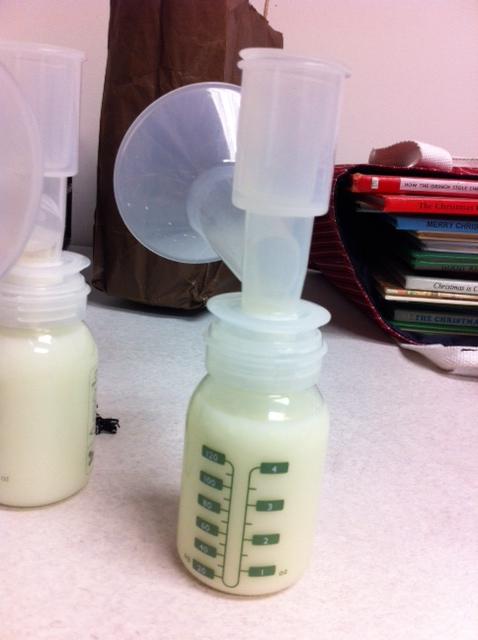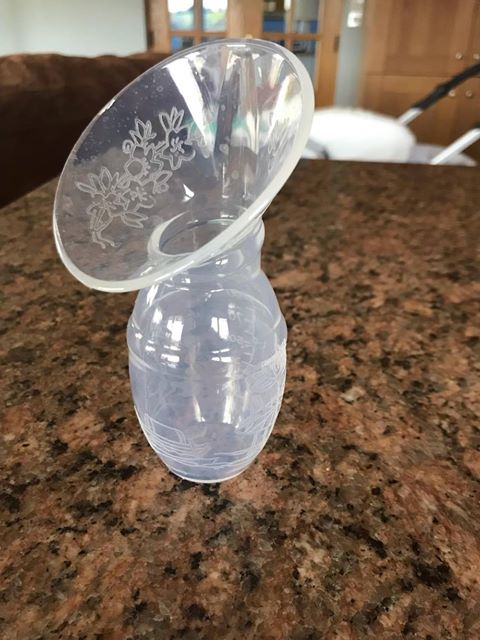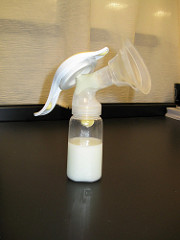I am an IBCLC (International Board Certified Lactation Consultant) in private practice in Northern Ireland and a La Leche League Leader with La Leche League of Ireland

By ParentingPatch - Own work, CC BY-SA 3.0, https://commons.wikimedia.org/w/index.php?curid=22576396
Expressing milk for your baby - the whole idea can seem a bit confusing at the start. Guidelines in the UK say to wait until 6 weeks before starting to express, but what if your baby doesn't latch at the start and you need to express? What if your baby isn't gaining weight as well as expected and you are advised to express? Clearly there are cases where the guidelines don't fit. Then you need to figure out how to express and when to express, and whether you want to use hand express or use a pump or a collection device, and how do you pick from the massive array of options?
In this blog I'll aim to give a brief overview of the kind of pumps and devices available for expressing, and what situations they are most appropriate for.
Hand Expressing
The first thing to point out is that nothing is actually needed to express for your baby, other than your hand and something to collect milk in. When you are producing colostrum in fact, hand expressing is often better than using a pump. This is because colostrum is low in volume, and collecting every drop is important. When using a pump it is very easy to lose those precious drops as they stick to the pump or the collecting bottle, whereas if you hand express directly into a container it is easier to collect every drop by syringe. So hand expressing is helpful for everyone during antenatal expression (if you have gestational diabetes during pregnancy for example, it may be suggested that you express during the last few weeks of your pregnancy as you are at higher risk of your milk "coming in" a little later than average). Hand expressing is also recommended in the first few days after birth until milk changes from colostrum into higher volume transitional milk (usually within the first 72 hours after birth). The volumes you might produce, are detailed in this previous blog on milk volume in the early days.
Once milk "comes in" (technically known as secretory activation or lactogenesis 2), volumes of milk become much larger. At this point many people decide to use a pump, but it is not necessarily required. Many people continue to hand express and build a full production of milk through hand expressing alone - but in order to do this you have to learn how to trigger a milk ejection / letdown (the muscular contractions which cause faster flow of greater volume of milk). This is a skill, and requires practice. It requires you to be comfortable with your breasts, your nipples, and with handling and manipulating them both.
Before beginning to express, it can help to gently massage the breasts for a couple of minutes, or perhaps place a warm wash cloth or towel on the breasts. This will encourage both blood flow and milk flow. Then lean slightly forward to allow gravity to play a role on the milk flow
There are 2 main techniques which are used and taught to hand express. The first is the Marmet technique, which involves starting with the finger and thumb 1-1.5 inches back from the nipple, pressing backwards into the chest wall and then rolling the finger and thumb forward. More details on this can be found on the Stanford Medicine website
The second technique is to place the fingers and thumb very close to the nipple and to work in and around the nipple. More details on this can be found here on a video from Maya Bolman IBCLC and Ann Witt MD.
The right technique for you will be the one which is comfortable and produces most milk. It's important to note that in order to stimulate a letdown (usually once you are past the colostrum phase), you need to stimulate nerves around the nipple. Some people find this works best by manipulating the nipple while expressing - perhaps rolling or massaging the nipple and around it.
Silicone Suction Bottle Pumps
This is an interesting category which includes devices like that Haakaa, NatureBond and other unbranded options available on the web. These are often described as manual pumps - but they don't actually have a pump action. They are simply a silicone bottle with a large flange on the top which attach to the breast via vacuum and apply continual vacuum to the breast and nipple. Some websites describe them simply as milk savers. It's important to note that different pump options are designed for very different things. The manufacturers of the Haakaa describe their device as being ideal for mums on the move, and perfect for travelling. The manufacturers of NatureBond also describe their device as being perfect for travelling. This is a very different kind of "pump" that you would get in a hospital to increase milk supply.
A suction collection device can be a very convenient way of collecting extra milk for someone who has a good supply of milk. If your breasts feel full, your baby only feeds from one side and is gaining well for example, a suction pump can be a great solution. It allows you to feed your baby on one side and to suction the silicone bottle to the other breast. Within a minute of the baby starting to feed you usually experience a letdown. This letdown happens in both breasts, so while the baby drinks milk on one side, the suction on the other works with the positive pressure of the letdown and milk drains into the bottle. It's a low cost, low effort way to collect milk.
Where these are likely not the best option is where a baby is not gaining well and/or not feeding well. I have seen breastfeeding forums where pumps like this have been suggested as appropriate to help a low gaining baby with a mum with low milk supply. A baby who is not gaining well likely needs to drink from both breasts however and draining milk into a bottle to feed later is often not helpful. In these situations the baby may need to drink from both breasts and afterwards pumping is needed to stimulate more milk production. Simply removing the milk into a bottle may not increase supply - it simply means baby is getting half the milk via a bottle rather than from the breast. If you are struggling with weight gain in your baby, look for some support from a Lactation Consultant (IBCLC), breastfeeding counsellor or HCP about strategies for increasing weight gain and milk production.

Pumps
Pumps essentially fall into 2 categories:
1. Manual vs Electric
2. Single vs Double
The categories are pretty self explanatory, and which pump is right for you will depend on what you need it for. A manual pump is one which you provide the pump mechanism. You are the pump motor, in essence. So the pump will typically have a bottle with a top attachment which has a pump handle and a flange to fit to the breast. You pump at the speed that suits you and the pumping/vacuum action stimulates the breast and triggers milk flow. This differs from the suction collection bottles which just have a constant vacuum (unless you try pumping by squeezing the bottle) and generally rely on the baby or another method on the other breast to stimulate a letdown. With a pump the on/off suction alternation usually stimulates a letdown. If you mostly feed at the breast, but want a pump to pump for times when you need to go out for a short time and it's not very frequent, a single manual pump is generally pretty low cost, good option. If you are not pumping each day, or perhaps just pumping once a day this might be the right choice for you.
If you are expressing every day, some people prefer to go for an electric pump, simply because it takes less effort. An electric pump is essentially the manual option with a motor attached. Rather than pumping a handle, you flip a switch but it uses the same on/off suction mechanism to trigger a letdown. It's usually quite a bit more expensive than the manual option.
The next decision is whether you want to go for a single pump or a double pump. The decision here is about time and cost. A single pump means you can only express from one breast at a time. A double pump means you can express both breasts at once. Obviously this means that if you are going to express from both breasts, a double pump will take half the time than a single pump will take. A double pump is usually more productive as well, as expressing both breasts at the same time is more stimulating to the body than expressing from one breast and then the other. Research suggests that double pumping doubles the prolactin burst when pumping, similar to what happens when twins breastfeed (Neifert & Seacat 1985), and produces more milk ejections and greater amounts of milk at 2, 5 and 10 mins (Prime et al 2012). A double pump is also much more expensive than a single since you have double the bottles, the flanges, the tubing etc.
When deciding on a pump it is basically a decision of effort vs cost - how often you are intending to express, the time involved, the time you want to spend and how much you can afford/how much you feel that time is worth! It may also depend on how necessary the pump is to building your supply. If your baby isn't feeding directly from the breast, it's week 2 and you need to increase milk production significantly, or you are in the position that you are re-lactating, then a double electric pump would be recommended, whereas if you need a pump for an ocassional trip for a hair cut, a passive suction bottle might be all you need. A hospital grade double electric pump would be considered to be the best possible option for establishing milk production if a baby isn't feeding - but these are too expensive for most families to buy. They are usually available to hire however for that kind of short term use. Which brand to choose is as much about marketing as anything else! Most pumps work by the same kind of action and principles.
Flanges
Pumps usually have a plastic or silicone shield (the flange) which attaches to the breast and creates an airtight seal (necessary to create vacuum). In order to create a seal and to work efficiently that flange needs to fit the individual woman and the size of her nipple. Nipples are all sorts of different sizes and shapes and lengths, and one flange isn't going to fit all of them, so pump manufacturers usually make a few different sizes.
Ideally what you want to see is that your nipple fits into the flange tunel and when the pump is working, the nipple is drawn in to the tunnel and released again, so it looks like the nipple is moving in and out. There should be space around the sides of the nipple so that there is no friction on the nipple as it is drawn into the tunnel, and there shouldn't be breast tissue drawn down into the tunnel - just the nipple and some areola. If the nipple is getting rubbed against the side walls of the flange tunnel you likely need a larger flange. If a lot of breast tissue is being pulled in then the flange is likely to big, and this usually leads to not a lot of milk flow. If you find you have a red rubbed area right around the base of the nipple, that also likely indicates that the pump flange is too small.
Wilson-Clay & Hoover (2005) published a study of nipple sizes (diameter of the nipple at the base) and found ranges from less than 12mm to greater than 23mm at the base. They also observed that nipples swell when pumping and so that needs to be taken into consideration when finding the right fit as well. Pumps are usually sold with a standard fit, often around 23-24mm). A study by Meier et al (2004) however, found that half of mothers expressing milk for their pre-term babies needed a larger 27-30mm flange.
If you are finding that pumping is causing pain/trauma, or you aren't getting much milk flow (despite the fact that the breasts feel full) then check the flange size in case you need to get a smaller or bigger flange.
How Much Pump Suction
Manual and simple electric pumps are generally easy to use and no or few knobs and whistles, but larger double, electric pumps tend to have options for stimulation and dials for level of suction - and it can be confusing to know what level to try. At the most basic you are aiming to get lots of stimulation at a level which continues to be comfortable. If the suction is so high that expressing is sore, this is counter productive. In order to trigger a milk ejection / letdown, we need to have a release of oxytocin. Pain and stress inhibits oxytocin so a pump with too high suction is not helpful. A good guide that people often use is to gradually increase the suction until it becomes uncomfortable and then just nudge it down below that, so that you have the maximum suction that is comfortable.
Buying New or Second Hand
On breastfeeding forums you can often see pumps for sale or being offered for free. If considering buying a pump which has been used before it's important to consider whether it is a open or closed system. A closed system has some kind of barrier mechanism between the areas where milk flows/collects and the pump mechanism. An open system can have milk coming into contact with the pump parts. The risk with an open system is that it is impossible to entirely clean and remove all traces of milk and mould or bacteria may grow in the motor of the pump unseen. If buying a 2nd hand pump then, it is recommended that you look for a closed system. A quick internet search will probably tell you if the pump you are thinking about is an open or closed system, if it doesn't state on the box, or you can contact the manufacturer for clarification.

https://www.flickr.com/photos/webchicken/3326768523/in/photolist-7ZSt6C-5z6ke-7ZSsJ5-64YynZ-s8q8ez-PSq9HQ
Cleaning Pumps & Bottles
Breastmilk is safe at room temperature for 4-6 hours (4 optimally, 6 considered satisfactory), which means that some people will leave a pump out with milk in it for 4-6 hours, pumping occasionally into it. After 4-6 hours however the milk needs refrigerated or used, and the pump and bottle need to be thoroughly cleaned. Look at the manufacturer's instructions for your pump, but in general the parts should firstly be rinsed to remove the milk, and then washed really well in hot soapy water. Manual cleaning of the parts is important. After washing well, the parts should be rinsed with cooled, boiled water and then left to air dry, perhaps on a piece of kitchen towel.
Optimising the amount you pump
To maximise the amount that you can pump, adding in some hand expression can really help. A good strategy can be to firstly spend a few minutes gently massaging the breast, or using a hot washcloth on the breast to encourage blood and milk flow. While expressing, if you are able to use your hands to compress your breasts this can help increase volume of milk expressed quite significantly. The trick here is finding a way to make your hands available. If using a single pump you may be able to use the other hand to compress. If double pumping, some people will hold the bottles with their forearms, freeing their hands to pump. Others will rig a bra to hold the flanges and leave their hands free for compression. There is a great video from Stanford Medicine here on how to do this compression. After pumping, there is usually some milk in the breast that the pump was unable to remove, so adding on a little massage and hand expression afterwards can often remove extra milk. A 2009 study by Morton et al found that adding in this hand stimulation increased milk production by 48% over the course of a day!
How Long & When To Express
This will very much depend on what you are wanting to achieve. Someone who is expressing for a small freezer stash will need very different expression strategies than someone who needs to build up a full milk supply through expressing alone. If you are wanting to occasionally express, or perhaps express once a day, this blog on protecting breastfeeding while expressing and bottle feeding may help. If you are needing to express to substantially increase supply or to establish milk production, then ideally you need to express 8-12 times a day (8 being the minimum). The key to remember when establishing supply is that you want to mimic a newborn baby. Newborns usually feed 10-12 times a day, and spend much of the day at the breast, and whether you are building supply through feeding at the breast, or expressing, it takes a lot of time, effort and breast stimulation. Frequency is key. Frequent milk expression sessions is more important than the time of each session, so 10 sessions of 10 minutes (100 mins total) will produce more stimulation and be more effective, than 5 expression sessions of 20 mins, even though it is the same time overall.
Expressing is something that many people have a love or hate relationship with. Just as breastfeeding is a skill, expression is a skill. A mum who is comfortable with hand expressing or has a pump she is comfortable with can find expressing rewarding. She sees to her milk flow and it allows her options around how breastfeeding looks for her and her family. A mum who is needing to express because her baby is struggling at the breast, or who needs to express because she has low milk supply can have a more conflicted relationship with expressing, some hating the whirr, whirr noise of the pump.
Expressing is a tool. It can help relieve engorgement, it can help to work out any blockages. It can increase milk production if needed, and provide another method of giving your breastmilk to your baby. It is a tool. Hand expressing small amounts antenatally (after 36-7 weeks) can also help to increase confidence in handling your own breasts, in how your breasts work and simply in the confidence of knowing that there is milk in there and it will be there for your baby. Getting more comfortable with our bodies can only be a good thing.
Blog coming soon on more detailed strategies on using expressing to increase milk supply.
If you have any questions about a consultation or would like to arrange to meet, please get in touch.
Further Reading
1. Stanford Medicine Video on Hand Expression: https://med.stanford.edu/newborns/professional-education/breastfeeding/hand-expressing-milk.html
2. Breast Massage & Hand Expression video from Maya Bolman IBCLC and Ann Witt MD: https://vimeo.com/65196007
3. Niefart M, Seacat J. Milk Yield and prolactin rise with simultaneous breast pumping. Presented at Ambulatory Paediatric Association Meeting, May 7-10, 1985, Washington DC
4. Prime DK, Garbin CP, Hartmann PE, Kent JC Simultaneous breast expression in breastfeeding women is more efficacious than sequential breast expression
Breastfeed Med. 2012 Dec;7(6):442-7. doi: 10.1089/bfm.2011.0139. Epub 2012 Oct 5. https://www.ncbi.nlm.nih.gov/pubmed/23039397
5. Wilson-Clay B, Hoover K. The Breastfeeding Altlas 3rd Ed. Austin, TX: Lactnews Press; 2005
6. Meier P, Motyhowski J, Zuleger J. Choosing a correctly fitted breast shield for milk expression.
Medela Messenger. 2004;21:8-9
7. ABM Clinical Protocol #8: Human Milk Storage Information for Home Use for Full-Term Infants, Revised 2017
BREASTFEEDING MEDICINE Volume 12, Number 7, 2017ª Mary Ann Liebert, Inc. DOI: 10.1089/bfm.2017.29047.aje https://abm.memberclicks.net/assets/DOCUMENTS/PROTOCOLS/8-human-milk-storage-protocol-english.pdf
8. Morton et al Combining hand techniques with electric pumping increases milk production in mothers of preterm infants
J Perinatol. 2009 Nov;29(11):757-64. doi: 10.1038/jp.2009.87. Epub 2009 Jul 2. https://www.ncbi.nlm.nih.gov/pubmed/19571815
9. Breastfeeding Network Leaflet on Expression and Storage: https://www.breastfeedingnetwork.org.uk/wp-content/pdfs/BFNExpressing_and_Storing.pdf
Important Information
All material on this website is provided for educational purposes only. Online information cannot replace an in-person consultation with a qualified, independent International Board Certified Lactation Consultant (IBCLC) or your health care provider. If you are concerned about your health, or that of your child, consult with your health care provider regarding the advisability of any opinions or recommendations with respect to your individual situation.
